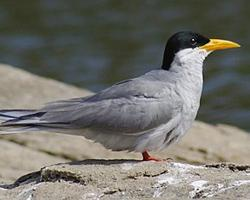
Stav ohrožení
| Ohrožen |
Popis zvířete
The Indian River Tern (Sterna aurantia), also known as the River Tern, is a fascinating bird species that belongs to the tern family Laridae. This medium-sized tern is predominantly found in the Indian subcontinent and Southeast Asia, thriving along rivers, lakes, and near coastal regions. It is particularly noted for its striking appearance and remarkable behaviors, making it an intriguing subject for birdwatchers and wildlife enthusiasts.Physical Characteristics:
The Indian River Tern has a slender and graceful body, with a length ranging from 38 to 43 cm and a wingspan of approximately 76 to 85 cm. One of the most distinctive features of this bird is its bright yellow beak, which has a black tip, giving it a dramatic contrast against its predominantly white plumage. During the breeding season, the adult terns sport a black cap that covers the head from the forehead to the nape, contrasting sharply with their white forehead and cheeks. The back, wings, and tail are a soft grey, while the underparts are pure white. Their legs and feet are a striking red, adding to their colorful appearance.
Behavior and Ecology:
Indian River Terns are highly social birds, often seen in large flocks, especially during the breeding season. They exhibit remarkable agility in flight, performing intricate maneuvers over water bodies as they hunt for fish. Their diet primarily consists of fish, which they catch with precision by plunging into the water from considerable heights. They are also known to consume insects and small crustaceans.
Breeding occurs once a year, with the onset of the summer monsoon. The terns nest in colonies on sandbanks or islands in rivers. Nests are simple scrapes in the ground, where the female lays 2 to 3 eggs. Both parents share the responsibility of incubating the eggs and feeding the chicks. The breeding season is a critical time, as their nesting sites are vulnerable to flooding and human disturbance.
Conservation Status:
The Indian River Tern is currently classified as Least Concern by the International Union for Conservation of Nature (IUCN). However, it faces threats from habitat destruction, pollution, and disturbance at nesting sites. The alteration of river flows due to dams and irrigation projects poses a significant threat to their breeding habitats. Conservation efforts are essential to monitor and protect their nesting sites and ensure the availability of clean water bodies for their sustenance.
In summary, the Indian River Tern is a remarkable bird species, admired for its beauty, agility, and fascinating behaviors. As an integral part of the ecosystems along rivers and water bodies in the Indian subcontinent and Southeast Asia, it plays a crucial role in the biodiversity of these regions. Efforts to conserve its habitat and ensure the sustainability of its populations are vital for the continued survival of this enchanting bird.
Podobná zvířata
Nové fotografie zvířat
Top 10 zvířat
- Chinese water dragon (Physignathus cocincinus)
- Galápagos tortoise (Geochelone nigra complex)
- Dolphin gull (Leucophaeus scoresbii)
- Japanese macaque (Macaca fuscata)
- Colombian red howler (Alouatta seniculus)
- Sea urchins (Echinoidea)
- Diana monkey (Cercopithecus diana)
- Moustached guenon (Cercopithecus cephus)
- Common reed warbler (Acrocephalus scirpaceus)
- Common house mosquito (Culex pipiens)


